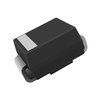Part Details for MSMBJ90CAE3 by Microsemi Corporation
Results Overview of MSMBJ90CAE3 by Microsemi Corporation
- Distributor Offerings: (0 listings)
- Number of FFF Equivalents: (0 replacements)
- CAD Models: (Request Part)
- Number of Functional Equivalents: (0 options)
- Part Data Attributes: (Available)
- Reference Designs: (Not Available)
Tip: Data for a part may vary between manufacturers. You can filter for manufacturers on the top of the page next to the part image and part number.
MSMBJ90CAE3 Information
MSMBJ90CAE3 by Microsemi Corporation is a Transient Suppressor.
Transient Suppressors are under the broader part category of Diodes.
A diode is a electrical part that can control the direction in which the current flows in a device. Consider factors like voltage drop, current capacity, reverse voltage, and operating frequency when selecting a diode. Read more about Diodes on our Diodes part category page.
Part Details for MSMBJ90CAE3
MSMBJ90CAE3 CAD Models
MSMBJ90CAE3 Part Data Attributes
|
|
MSMBJ90CAE3
Microsemi Corporation
Buy Now
Datasheet
|
Compare Parts:
MSMBJ90CAE3
Microsemi Corporation
Trans Voltage Suppressor Diode, 600W, 90V V(RWM), Bidirectional, 1 Element, Silicon, DO-214AA, ROHS COMPLIANT, PLASTIC, SMBJ, 2 PIN
|
| Pbfree Code | Yes | |
| Rohs Code | Yes | |
| Part Life Cycle Code | Transferred | |
| Ihs Manufacturer | MICROSEMI CORP | |
| Part Package Code | DO-214AA | |
| Package Description | ROHS COMPLIANT, PLASTIC, SMBJ, 2 PIN | |
| Pin Count | 2 | |
| Reach Compliance Code | not_compliant | |
| ECCN Code | EAR99 | |
| HTS Code | 8541.10.00.50 | |
| Additional Feature | HIGH RELIABILITY | |
| Breakdown Voltage-Max | 111 V | |
| Breakdown Voltage-Min | 100 V | |
| Configuration | SINGLE | |
| Diode Element Material | SILICON | |
| Diode Type | TRANS VOLTAGE SUPPRESSOR DIODE | |
| JEDEC-95 Code | DO-214AA | |
| JESD-30 Code | R-PDSO-J2 | |
| JESD-609 Code | e3 | |
| Moisture Sensitivity Level | 1 | |
| Non-rep Peak Rev Power Dis-Max | 600 W | |
| Number of Elements | 1 | |
| Number of Terminals | 2 | |
| Operating Temperature-Max | 150 °C | |
| Operating Temperature-Min | -65 °C | |
| Package Body Material | PLASTIC/EPOXY | |
| Package Shape | RECTANGULAR | |
| Package Style | SMALL OUTLINE | |
| Peak Reflow Temperature (Cel) | 250 | |
| Polarity | BIDIRECTIONAL | |
| Power Dissipation-Max | 1.38 W | |
| Qualification Status | Not Qualified | |
| Rep Pk Reverse Voltage-Max | 90 V | |
| Surface Mount | YES | |
| Technology | AVALANCHE | |
| Terminal Finish | MATTE TIN | |
| Terminal Form | J BEND | |
| Terminal Position | DUAL | |
| Time@Peak Reflow Temperature-Max (s) | 30 |
MSMBJ90CAE3 Frequently Asked Questions (FAQ)
-
The recommended PCB footprint for the MSMBJ90CAE3 is a standard SOT-23 package with a 1.3mm x 1.3mm body size and 0.5mm lead pitch. A minimum pad size of 0.6mm x 0.6mm is recommended for reliable soldering.
-
To ensure reliable operation in high-temperature environments, it is recommended to derate the maximum junction temperature (Tj) by 1°C for every 1W of power dissipation above 25°C. Additionally, ensure good thermal conduction by using a heat sink or thermal pad, and follow proper PCB design and layout guidelines.
-
The maximum surge current rating for the MSMBJ90CAE3 is 100A for a 10/1000μs waveform, as per the IEC 61000-4-5 standard. However, it's essential to consult the datasheet and application notes for specific surge current requirements and protection circuitry design.
-
Yes, the MSMBJ90CAE3 can be used in switching regulator applications, but it's essential to ensure that the device is operated within its safe operating area (SOA) and that the switching frequency is within the recommended range. Additionally, proper PCB layout, decoupling, and filtering are crucial to minimize electromagnetic interference (EMI) and ensure reliable operation.
-
The bias resistor values for the MSMBJ90CAE3 depend on the specific application and operating conditions. As a general guideline, the bias resistors should be chosen to ensure that the device operates within its recommended operating voltage and current ranges. A good starting point is to use the values recommended in the datasheet or application notes, and then adjust them based on the specific application requirements.
